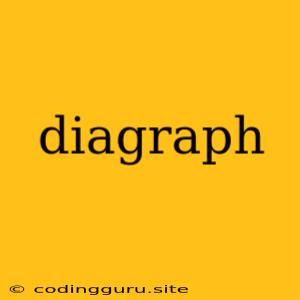What is a Diagraph?
A diagraph is a powerful tool in the field of graph theory. It's a directed graph, meaning that the relationships between its nodes (vertices) are unidirectional. Instead of simply indicating a connection, it depicts a flow or influence from one node to another. Imagine a map showing one-way streets; that's a simple analogy for a diagraph.
What Makes a Diagraph Special?
Diagraphs are distinct from regular graphs due to their directionality. This feature allows us to represent more complex relationships, like:
- Flow of Information: Representing how data moves through a network.
- Dependency Relationships: Mapping how tasks or processes depend on each other.
- Sequence of Events: Illustrating the order of steps in a process or workflow.
- Web Link Structure: Visualizing the interconnectedness of websites through hyperlinks.
Diagraph Applications
Diagraphs are used in various fields, including:
- Computer Science: Algorithm analysis, data structures, and network modeling.
- Operations Research: Scheduling, project management, and optimization problems.
- Social Sciences: Modeling social networks, information diffusion, and influence analysis.
- Biology: Representing metabolic pathways and genetic networks.
Types of Diagraphs
- Acyclic Digraph (DAG): A diagraph without cycles, where no path can lead back to a previously visited node. DAGs are useful for representing dependencies and scheduling tasks.
- Strongly Connected Digraph: A diagraph where every pair of nodes has a path connecting them in both directions. These diagraphs are essential for understanding communication networks and interconnected systems.
Diagraph Representations
Diagraphs can be represented in various ways:
- Adjacency Matrix: A matrix where rows and columns represent nodes, and entries indicate the presence (or absence) of a directed edge between them.
- Adjacency List: A list of nodes, where each node is associated with a list of its outgoing neighbors.
- Edge List: A list of tuples, each representing a directed edge connecting two nodes.
Advantages of Using Diagraphs
- Visual Clarity: Diagraphs provide a clear and intuitive representation of directed relationships.
- Complexity Reduction: They simplify complex systems by focusing on the flow of information or influence.
- Problem-Solving: They facilitate the analysis and solution of problems related to dependencies, sequencing, and network optimization.
Examples of Diagraphs in Action
- Social Networks: Imagine a diagraph representing a social network. Each node represents a person, and a directed edge indicates a "follows" relationship.
- Project Management: A diagraph can map out a project, with nodes representing tasks and directed edges representing dependencies between them. This helps visualize critical paths and identify potential delays.
Diagraph Implementation
Diagraphs can be implemented using various programming languages and libraries. Some popular options include:
- Python: Using libraries like NetworkX, graph-tool, or igraph.
- JavaScript: Utilizing D3.js for visualization and network analysis.
- C++: Implementing diagraph structures from scratch or using Boost Graph Library.
Diagraph Exploration
Here are some tools and techniques for exploring and analyzing diagraphs:
- Topological Sort: A linear ordering of nodes in a DAG, where each node appears before all of its descendants.
- Shortest Path Algorithms: Finding the shortest path between two nodes in a diagraph, for example, using Dijkstra's algorithm or A* search.
- Strongly Connected Components: Identifying groups of nodes where each node is reachable from every other node in the group.
Conclusion
Diagraphs are essential tools for representing and analyzing directed relationships. Their ability to model flows, dependencies, and sequences makes them valuable in numerous fields. Understanding diagraphs empowers us to visualize complex systems, solve problems, and gain insights into the structure and dynamics of interconnected networks.
